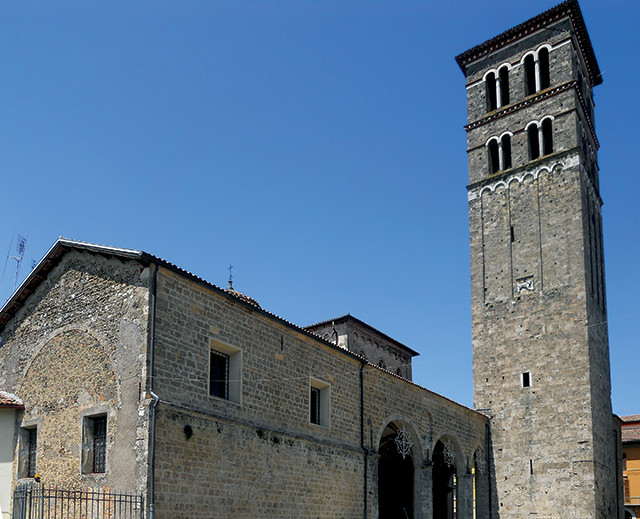
by Rebecca Heisman Friday, May 20, 2016

Researchers combined written historical records housed in the Abbey of Farfa and Rieti Cathedral, seen here, with environmental records from sediment and pollen to see how the landscape of Italy's Rieti Valley changed through medieval times. Credit: Alessandro Antonelli, CC BY 3.0.
It’s easy to anecdotally pin environmental changes and their societal impacts on shifting climates. But when scientists and historians came together to look at environmental changes through the warm Medieval Climate Anomaly and cold Little Ice Age in Rieti, Italy, they found that the real story of climate and social change is much more complex — and interesting.
Rieti is a wetland-filled valley in the mountains north of Rome that has undergone a series of environmental shifts since it was first settled in the Iron Age almost three millennia ago, according to written historical records from the region. Scott Mensing, a paleoecologist at the University of Nevada and lead author of a new study in the journal Anthropocene looking into the region’s past, wanted to see how physical evidence of past environmental changes would compare to the written records.
He and his colleagues collected sediment cores from one of the valley’s modern remnant lakes, then dated the sediments and analyzed the pollen to reconstruct local plant populations over time. They also recruited local historians who could read medieval Italian to analyze archives of historical documents kept at the valley’s Farfa Abbey and the Rieti Cathedral. Thus, Mensing’s team matched the changes in local vegetation recorded by pollen in the sediment cores with accounts of social upheaval recorded in church documents.
The results show how climate change and societal forces influence each other, Mensing says. After being left undeveloped by the Romans, and by the Ostrogoths who succeeded them, the forested Rieti Basin was converted into grassland and pasture between A.D. 870 and 925. Rather than being closely tied to climate, this transformation occurred before the height of the warm Medieval Climate Anomaly, driven by the arrival of the Lombards and new trends toward large, intensely farmed monastic estates.
Then, starting in the late 14th century, cooler, wetter conditions during the Little Ice Age, combined with depopulation caused by the plague, resulted in the plain being largely abandoned, and it reverted to swampland and forest. These conditions “caused people to abandon the land, and it returned to forest remarkably quickly. Within 50 or 60 years, you had forest back in an area that was probably all pasture before that,” Mensing says. “The speed of these transitions really surprised me.”
It was advances in hydrologic engineering, not the return of a more amenable climate, which eventually allowed the valley to be returned to cultivation: In 1596, near the height of the Little Ice Age, Pope Clemente VII commissioned architect Giovanni Fontana to build a new channel that drained the valley once and for all.
“Studies like this are important for understanding societal responses to climate change, and they provide a wake-up call to the fact that humans have been impacted by climate change in the past, even within single human life spans,” says Elizabeth Thomas of the University at Buffalo, who was not involved in the study. “It’s also interesting to note that societies can learn, adapt and engineer solutions to changing environments,” she says.
© 2008-2021. All rights reserved. Any copying, redistribution or retransmission of any of the contents of this service without the expressed written permission of the American Geosciences Institute is expressly prohibited. Click here for all copyright requests.